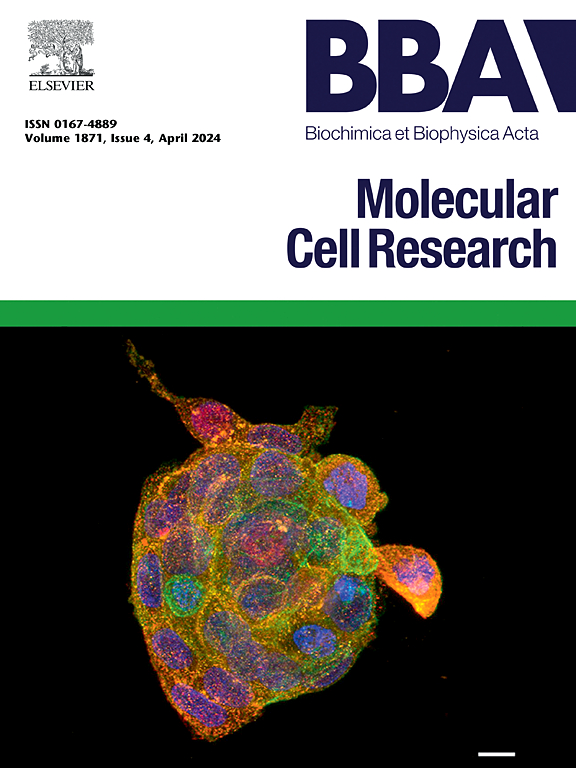CHIP modulates Wnt/β-catenin signalling in colorectal cancer through proteasomal degradation of DDX17
IF 3.7
2区 生物学
Q1 BIOCHEMISTRY & MOLECULAR BIOLOGY
Biochimica et biophysica acta. Molecular cell research
Pub Date : 2025-08-22
DOI:10.1016/j.bbamcr.2025.120049
引用次数: 0
Abstract
The C-terminus of Hsc70-interacting protein (CHIP), an E3 ubiquitin ligase, plays a pivotal role in cellular protein homeostasis by targeting client proteins for proteasomal degradation. DEAD-box RNA helicase DDX17 is a key regulator of RNA metabolism and has been implicated in various cancer-related processes, including Wnt/β-catenin signalling and EMT. In this study, we uncover a novel regulatory axis involving CHIP and DDX17 responsible for modulation of Wnt/β-catenin signalling in colorectal cancer (CRC). Bioinformatic analyses of CPTAC database and immunohistochemical analysis of clinical samples revealed a significant negative correlation between CHIP and DDX17. By using immunoprecipitation-mass spectrometry we have identified DDX17 as a high-confidence interacting partner of CHIP, which was validated through co-immunoprecipitation, domain-mapping, immunocytochemistry, and molecular docking studies, pinpointing the TPR domain of CHIP is essential for this interaction. Mechanistically, CHIP overexpression led to accelerated degradation of DDX17, resulting in reduced β-catenin mRNA stability, leading to the suppression of Wnt/β-catenin signalling that results in G1 arrest and decreasing proliferation and EMT. Conversely, CHIP knockdown stabilized DDX17, hence promoting β-catenin signalling that leads to oncogenic phenotype. Our results suggest that CHIP exerts a tumor-suppressive phenotype in CRC by destruction of DDX17, thereby attenuating β-catenin-driven oncogenic processes. Altogether, this study identifies a novel “CHIP–DDX17–β-catenin” axis as a critical regulatory mechanism in CRC.
CHIP通过蛋白酶体降解DDX17调节结直肠癌中Wnt/β-catenin信号
hsc70相互作用蛋白(CHIP)的c端是一种E3泛素连接酶,通过靶向客户蛋白进行蛋白酶体降解,在细胞蛋白稳态中起关键作用。DEAD-box RNA解旋酶DDX17是RNA代谢的关键调节因子,参与多种癌症相关过程,包括Wnt/β-catenin信号传导和EMT。在这项研究中,我们发现了一个涉及CHIP和DDX17的新的调控轴,负责调节结直肠癌(CRC)中Wnt/β-catenin信号传导。CPTAC数据库的生物信息学分析和临床样本的免疫组织化学分析显示CHIP与DDX17呈显著负相关。通过免疫沉淀-质谱法,我们确定了DDX17是CHIP的高置信度相互作用伙伴,通过共免疫沉淀、结构域定位、免疫细胞化学和分子对接研究验证了这一点,确定CHIP的TPR结构域对这种相互作用至关重要。从机制上讲,CHIP过表达导致DDX17降解加速,导致β-catenin mRNA稳定性降低,从而抑制Wnt/β-catenin信号传导,导致G1阻滞,减少增殖和EMT。相反,CHIP敲除稳定了DDX17,从而促进了导致致癌表型的β-catenin信号传导。我们的研究结果表明,CHIP通过破坏DDX17在CRC中发挥肿瘤抑制表型,从而减弱β-catenin驱动的致癌过程。总之,本研究确定了一个新的“CHIP-DDX17 -β-catenin”轴作为CRC的关键调控机制。
本文章由计算机程序翻译,如有差异,请以英文原文为准。
求助全文
约1分钟内获得全文
求助全文
来源期刊
CiteScore
10.00
自引率
2.00%
发文量
151
审稿时长
44 days
期刊介绍:
BBA Molecular Cell Research focuses on understanding the mechanisms of cellular processes at the molecular level. These include aspects of cellular signaling, signal transduction, cell cycle, apoptosis, intracellular trafficking, secretory and endocytic pathways, biogenesis of cell organelles, cytoskeletal structures, cellular interactions, cell/tissue differentiation and cellular enzymology. Also included are studies at the interface between Cell Biology and Biophysics which apply for example novel imaging methods for characterizing cellular processes.

 求助内容:
求助内容: 应助结果提醒方式:
应助结果提醒方式:


